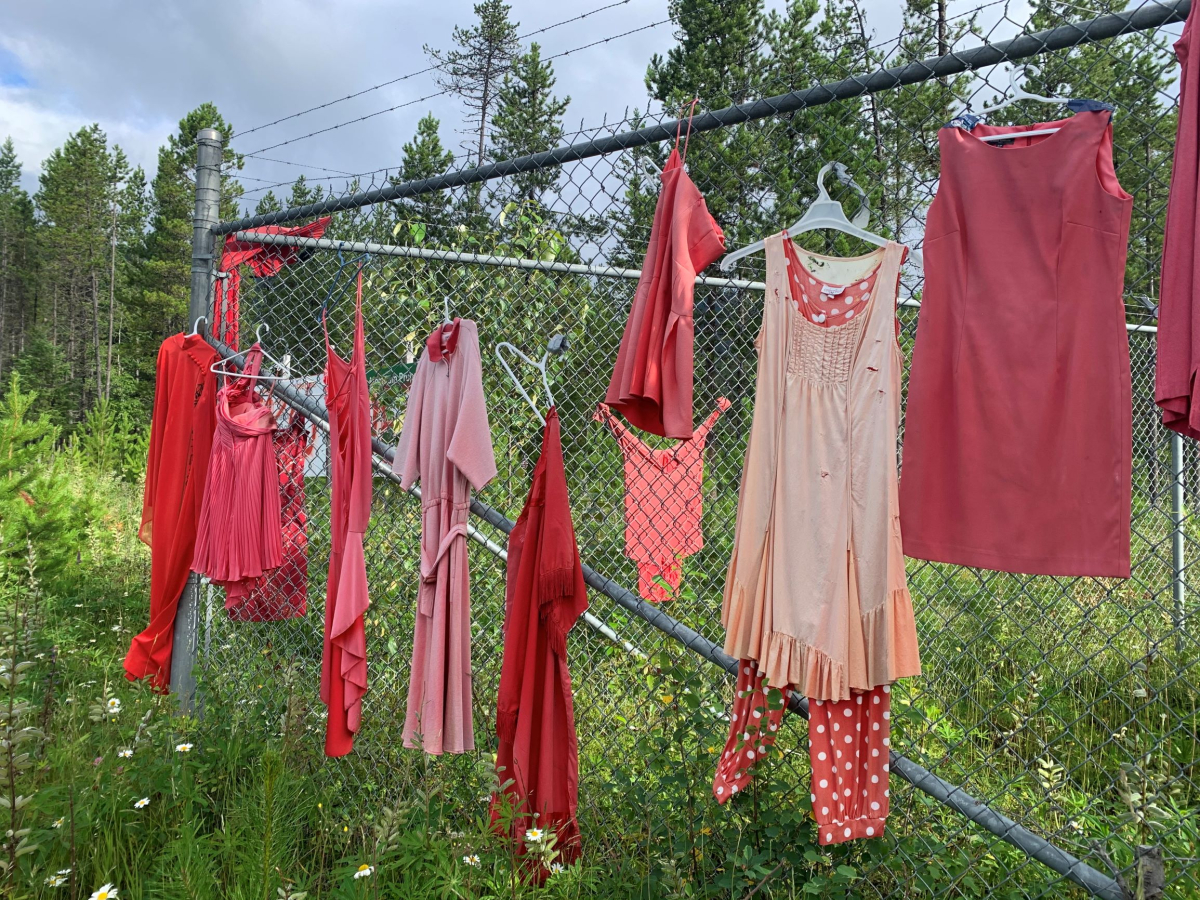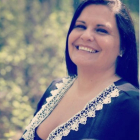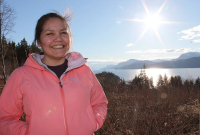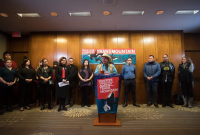Support strong Canadian climate journalism for 2025
Tensions were high when I arrived in Blue River, B.C., on July 24.
I was there to cover a protest being held by townspeople upset with Secwépemc land defenders called Tiny House Warriors who have been occupying a piece of their traditional lands to oppose pipeline expansion through the area.
I expected friction. But I never imagined I’d be leaving just two days later afraid for my life.
A rally planned by locals and supporters of oil and gas who want the Tiny House Warriors opposition to the Trans Mountain pipeline expansion gone was planned for the morning after I arrived.
Everyone seemed on edge and uncertain about what would unfold.
I was ready for a day that would be long, exhausting emotionally, mentally and spiritually. The stories I cover often are, but this one felt even more heightened.
The day began with prayers.
I was invited to join two elders and a few pipe carriers as they held a ceremony across from the Trans Mountain pipeline pump station.
The elders prayed for the day, for the people on both sides of the divides. Prayers of thanks were sent for Mother Earth and all she provides and continues to provide for our sustenance.
The smell of sage, cedar and other smudge was soothing. A slight wind carried the smoke high, weaving in and away from the four directions it decided to blow.

But the camouflage gear some land protectors wore was a reminder of a people at war and on guard.
They are on guard for the health of Secwépemc lands, waters and air. They are protecting the land against encroachment and development that’s harmful to the intrinsic ecosystems of their ancestors and future generations.
It just so happened I had brought a camouflaged hoodie with me. Because it was comfy.
I didn’t even connect the two when I packed, until I got to Blue River.
Then I knew I couldn’t wear it, because if something were to happen and police got involved, there’s a good chance I’d be targeted if I wore it. Not only was I concerned about potential police violence, but also violence from counter-protesters.
I didn’t want to put myself in the line of fire.
I also packed a favourite T-shirt that reads “Strong, Resilient, Indigenous” printed in white letters on a black background. Oh, darn. I couldn’t wear that one either. It would identify me as the proud Indigenous woman I am.
I didn’t want to become a target.
At the ceremony, seeing and hearing our people sharing their stories of brokenness, violence and strength, outside a chain-link fence that separated them from this pipeline project owned by the Canadian government was symbolic of the broken relationships we’ve been in for more than 150 years.
No violence in a physical sense broke out that day. But I did encounter racists shouting slurs while I was reporting at the counter-rally. And I witnessed a white man violently ripping red dresses, symbols for missing and murdered Indigenous women and girls (MMIWG), down from where they were hung in trees and on fences.

A couple of hours before sunset, I joined Neskonlith First Nation elected Chief Judy Wilson and her 88-year-old mother, Minnie Kenoras Manuel, for a drive. Chief Judy and her mother are Secwépemc, and travelled to Blue River to support the Tiny House Warriors.
The mother and daughter wanted to see a bit of the countryside, and I was eager to join them in the back seat.
Chief Judy talked about her work advocating for Indigenous rights and sovereignty and for the environment. She shared some history of the Secwépemc traditional territories and so did her mother, who is smart as a whip and overflows with eccentric character.
Chief Judy also shared something that turned out to be significant later that evening: Two years ago, Chief Judy travelled to Houston, Texas, to the Kinder Morgan headquarters to meet with Kinder Morgan shareholders at the company’s annual general meeting. She was tasked with informing the pipeline CEOs, face to face, that there was Secwépemc and other Indigenous opposition to the TMX. She was also there to tell them that Kinder Morgan was violating Indigenous human rights.
The exchange, she said, didn’t go well, and Richard Kinder became visibly upset and walked out of the room.
In 2018, Prime Minister Justin Trudeau bought that pipeline from Kinder Morgan in an apparent eleventh-hour attempt to save it from dissipating.
So, it’s now the Canadian state, and with it Canadian taxpayers, against the Indigenous Peoples who oppose its construction.
Our drive ended with Chief Judy singing classic country and Elvis songs with her mother holding hands together, while I joined in when I knew the words.
It was a lovely and inspiring end to my day. Or so I thought.

When I arrived back at my hotel, my two-year-old baby daughter was already asleep. She was on this trip because I had been working away from home a lot and wanted to keep her with me this time. Her dad came to care for her while I worked.
I washed my face and got into cozier clothes.
That’s when I got a notification on my phone. I get a lot of social media alerts, especially when I’m out on a story. But this one caught my eye.
It was from Periscope. That’s an app I use to broadcast live coverage to my Twitter account. I had been using it during the day.
The notification was of a new, verified follower. I was intrigued to know who that verified follower was, so I checked it.
I didn’t recognize the name.
An acronym: @IHIT Homicide Team.
Wait, who? What homicide team? Who’s killing whom? What? Weird.
So I googled it. And when I read it I was shocked.
IHIT stands for Integrated Homicide Investigations Team, RCMP E Division.
It’s a specialized unit responsible for investigating homicides, high-risk missing persons and suspicious deaths in B.C.’s Lower Mainland.

Why were they suddenly following me, at night when I’m reporting on a highly controversial subject out in the middle of practically nowhere? Blue River’s population is less than 300.
It is no secret Canada has been monitoring and tracking the behaviour of Indigenous groups for years. Most notably the RCMP, in an operation dubbed “Project Sitka,” compiled a list of 89 individuals considered “threats” according to the RCMP report, obtained under the Access to Information Act by two researchers working on a book about state surveillance of Indigenous Peoples. That RCMP operation and other surveillance by police, military, national security intelligence agencies and other government bodies has been called “disproportionate and alienating.”
All that history was in my mind as I stared at my phone wondering, was the RCMP tracking me as a terrorist?
Plus, I’m an Indigenous woman, there’s a crisis of MMIWG in this country. And some families of MMIWG I’ve recently spoken with tell me they believe the RCMP could be behind some murders and disappearances of Indigenous women along the Highway of Tears in northern B.C.
Wild, right? True or not, it’s heartbreaking they even believe there’s a connection.
But, I’m a journalist. Is that why they suddenly followed me? OK, but why the homicide investigations unit?
I was also recently reporting heavily on police violence and killings against Indigenous Peoples in Canada.
There is long-standing mistrust and injustice between the RCMP/Canadian police forces and Indigenous Peoples. That mistrust has been going on since the founding of the Canadian state.
You could imagine the thoughts running through my mind as I was looking at my phone, in the dark of night, on a high-tension assignment far from home.
When the Tiny House Warriors are patrolled and droned by police on a regular basis.
When Wet’suwet’en are forcibly removed from their lands to make way for a pipeline to be built.
When police shot and killed 26-year-old Tla-o-qui-aht woman Chantel Moore on June 4, during a wellness check.
Just over a week later police shot and killed Rodney Levi of Metepenagiag Mi’kmaq First Nation in New Brunswick.
In April, Winnipeg police killed three Indigenous Peoples in 10 days.
I met with Athabasca Chipewyan First Nations Chief Allan Adam in June. He was beaten and arrested by Fort McMurray RCMP over an expired licence plate.
I could go on and on.
I have journalist colleagues such as Jerome Turner from the Gitxsan Nation who had police guns pointed in his face while covering the Wet’suwet’en raids in February.
My friend, photojournalist Amber Bracken, also covered the raids and was on the front lines of violence incited against the Wet’suwet’en, along with a handful of other journalists.
And TC Energy is the contested CGL LNG pipeline owner behind the crisis in Wet’suwet’en lands. It’s also the same company contracted to build the TMX.
The threats are real.
I was scared.
I went down the hall and knocked on Chief Wilson’s room to show her.
She responded pretty nonchalantly.
“Ya, they’re trying to intimidate you.”
The way she said it was matter-of-fact and with conviction.
That made the threat I felt even more tangible.
She apologized when she saw the look of shock on my face.
“I’m sorry, I’m so used to this, I should’ve been gentler. This is normal for us,” she said.
Used to this? Yes, this and more she’s dealt with from police and authorities throughout her years of asserting her rights.
This, to her, was no surprise.
OK.
I went back to my room and contacted my editor.
She was concerned and advised me to barricade my door. I did and it was unnerving.
I brought my baby’s playpen close to the bed and prayed.
The feeling sucked. I shouldn’t have to feel afraid as a journalist, but I was because of how this country treats Indigenous Peoples.
I was curious to see who else the IHIT team was following.
The account had almost 500 followers, but was only following 12.
So, why the heck did they randomly follow me?
I wondered.
The account followed a few mainstream news stations from Vancouver and a couple other random accounts.
But it followed another verified account, so I checked it out.
Another acronym: @HCSOTexas.
It was the Houston, Texas, and area sheriff's department ... chills ran up my spine.
Adrenaline rushed through my veins and I momentarily wanted to vomit.
Remember Chief Judy sharing she went to Houston to address the former pipeline owners?
Yeah. So why was this IHIT account randomly following the Houston police account when it’s all the way up in B.C., Canada?

In December 2019, CTV News Calgary reported that after more than five years into an economic downturn, Alberta oil and gas companies continue to make a shift south of the border, relocating deep into the heart of Texas.
“Energy industry analysts say in the last five years, 'hundreds' of companies from Western Canada have migrated to Texas, specifically in the Houston area, as regulatory uncertainty and a sluggish economy persists in Alberta.”
Serendipitous? Maybe. But that’s not how I took it.
Just this week, I learned that three Kukuma Indigenous Peoples in Peru were killed, reportedly by state police, after a Calgary-based oil and gas company called for “enhanced security” at one of its pump stations there.
The Kukuma were protesting at the PetroTal oil pump station due to concerns of the spread of COVID-19 and ongoing environmental impacts to their lands.
Since the deaths have made global headlines, PetroTal — which has its headquarters in Houston, Texas — has now shut down operations at that oilfield.
And that Canadian-based company, with a Canadian executive and Canadian executive directors from the Prairies, called 40 national police guards in to protect their pump station.
This is what Indigenous Peoples get when protecting their territories and asserting their rights.
I was supposed to leave Blue River a couple of days later. Instead, I decided to leave the morning after this alarming encounter with the IHIT unit. I was honestly afraid for my life.
Would I be scooped out and snipped because the RCMP is watching me? It’s not too far-fetched, given my reporting includes the Indigenous perspective of opposition to the economic interests of the Canadian state because it owns TMX.
Journalists around the world are often threatened, stalked and harmed for doing their job when it comes to holding power to account.
We don’t think this kind of intimidation could happen to a journalist in Canada, but just look at the recent actions of industry here and internationally.
There were several “dead” areas where there’s no cell service driving through the mountains back home.
Some police work undercover, and Chief Judy told me she and others noticed them lurking within sight at the ceremony.
I wasn’t looking forward to being on the road under these circumstances.
She also shared an email from Amnesty International Canada secretary general Alex Neve, sent two days before the counter-protests.
Neve wrote to the B.C. RCMP deputy commissioner, chief superintendent and assistant commissioner to express concerns for the safety of the land defenders and urged the RCMP to play a peacekeeping role, and to remind them to uphold Indigenous rights.
Imagine that. Indigenous Peoples in Canada having to rely on an international human rights organization to advocate for their safety.
I prayed again.
The drive home felt heavy. My heart beat faster along the way as I thought of the constant state of fear and intimidation thousands of Indigenous Peoples face every day.
Then I was angry.
How dare they? Even if it was a coincidence, how dare they put us in these positions that we feel afraid for our lives?
I was doing my job as a journalist. And, as a journalist, I have certain freedom of the press rights. But I felt threatened. I felt my baby was in danger, too.
Our lives as Indigenous Peoples — and especially Indigenous women — are in endless danger.
Something pointed out to me by land protectors and advocates of MMIWG is that RCMP and other law enforcement do the bidding of corporations to enforce injunctions that remove Indigenous Peoples from their lands, but do next to nothing when it comes to solving the genocide of MMIWG.
That might sound like opinion. But the national inquiry into MMIWG pointed at law enforcement’s complacency in “Canada’s staggering rates of violence against Indigenous women, girls and 2SLGBTQQIA people.”
So my reality sitting alone — and scared — in that hotel room with my baby was a different one than many of my non-Indigenous colleagues. It was that reality that pushed me to leave as soon as day broke. It was that reality that left me fearing for my safety and the safety of my child.
I don’t want to feel afraid for my life in my own country from its authorities ever again. This is why the narrative must change. I have a voice. Others do not.
If the RCMP and other law enforcement want to do their jobs of serving and protecting, I don’t want them to waste it on investigating journalists for reporting from the front lines.
On Monday, after I returned home, I called Frank Jang, the communications manager who manages the IHIT Periscope account. He answered.
I introduced myself and asked why he followed me. He was surprised and told me he randomly found me on Periscope and wanted to follow my work.
I told him it freaked me out when he followed me; Periscope showed me that IHIT had watched replays of my coverage that day and on the night when I received the notification.
He was cordial and understood my reasoning for being concerned. He assured me it was a coincidence.
I told him I’m also working on stories in B.C. regarding the MMIWG crisis for an international audience.
He said if I need to be connected to a unit for interviews he’s more than happy to help facilitate.
I’ll definitely be following up.






Comments
So disturbing. We need to hear more from Indigenous reporters like Brandi. Our mainstream news media have been sorely lacking voices like hers.
Please stay strong in your convictions and keep telling the truth.
Stay safe and may divine love protect you.
Excellent reporting!